Abstract
The intestinal colonization and translocation of enterococci was studied in mice treated intramuscularly with metronidazole or clindamycin, with or without oral streptomycin. Treatment with metronidazole resulted in selective elimination of strictly anaerobic cecal bacteria, with a 100-fold increase in the numbers of aerobic and facultative gram-negative bacilli and a 10,000-fold increase in the numbers of aerobic and facultative gram-positive species. Clindamycin had a similar effect on the cecal flora except that the numbers of aerobic and facultative gram-positive bacteria decreased at least 10-fold. The predominating gram-positive species in the cecal flora or metronidazole-treated mice was an enterococcus, but this organism could not be recovered from the ceca of clindamycin-treated mice. Translocating bacteria (primarily gram-negative enteric bacteria) were recovered from the mesenteric lymph nodes of the majority of mice given metronidazole or clindamycin. Gram-positive bacteria were not recovered from the mesenteric lymph nodes of 20 clindamycin-treated mice, whereas 26% of 19 metronidazole-treated mice had translocating enterococci. With addition of streptomycin to the metronidazole and clindamycin regimens, mice treated with metronidazole-streptomycin became colonized predominantly with an enterococcus, and this was the only translocating species recovered from 13% of 23 mice; however, enterococci could not be detected in the ceca of clindamycin-streptomycin-treated mice, and Bacillus spp. were recovered from the mesenteric lymph nodes of 8% of 24 mice, reflecting the composition of the cecal flora. The apparent elimination of enterococci from the ceca of clindamycin and clindamycin-streptomycin-treated mice was inconsistent with the observation that the average (n=6) peak levels of clindamycin in blood and ceca were 25 and 21 microgram/ml, respectively, whereas the in vitro MIC was 128 microgram/ml. However, this apparent in vivo activity of clindamycin against enterococci was not evident in mice given 10(9) oral enterococci; the concentrations of cecal enterococci in both clindamycin-streptomycin- and metronidazole-streptomycin-treated mice were 10(10) to 10(11) enterococci per g, with translocating enterococci recovered from approximately half of these antibiotic-treated mice. Thus antibiotic therapy with metronidazole, clindamycin, metronidazole-streptomycin, and clindamycin-streptomycin resulted in a wide variation in the cecal population levels and translocation frequencies of enterococci. This variation appeared to be related to the discrepancy between the in vivo and in vitro activities of clindamycin against enterococci.
Full text
PDF
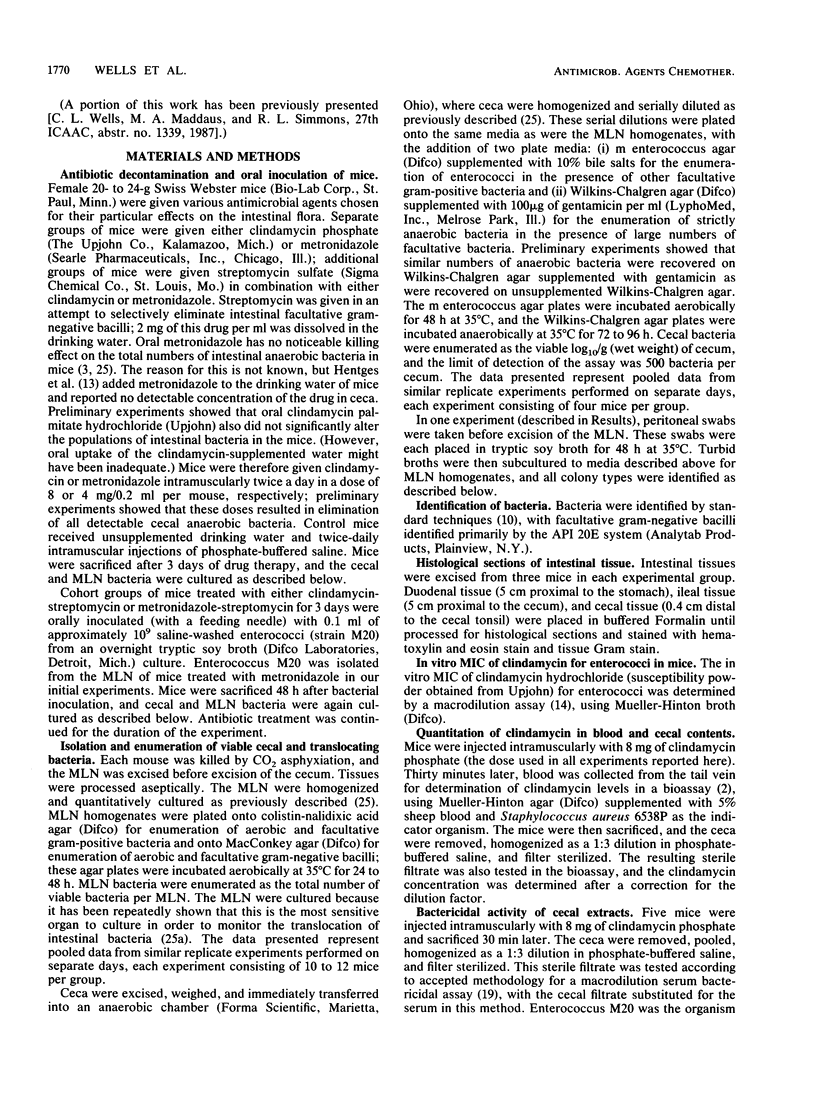
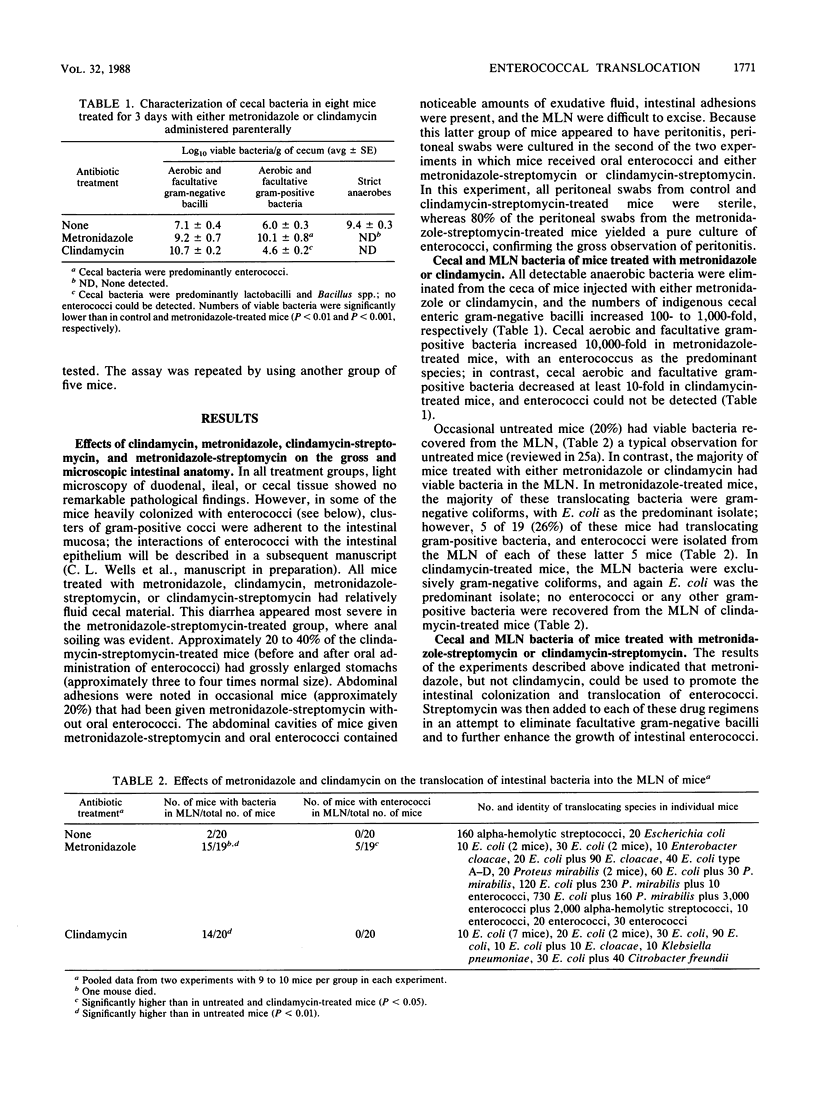
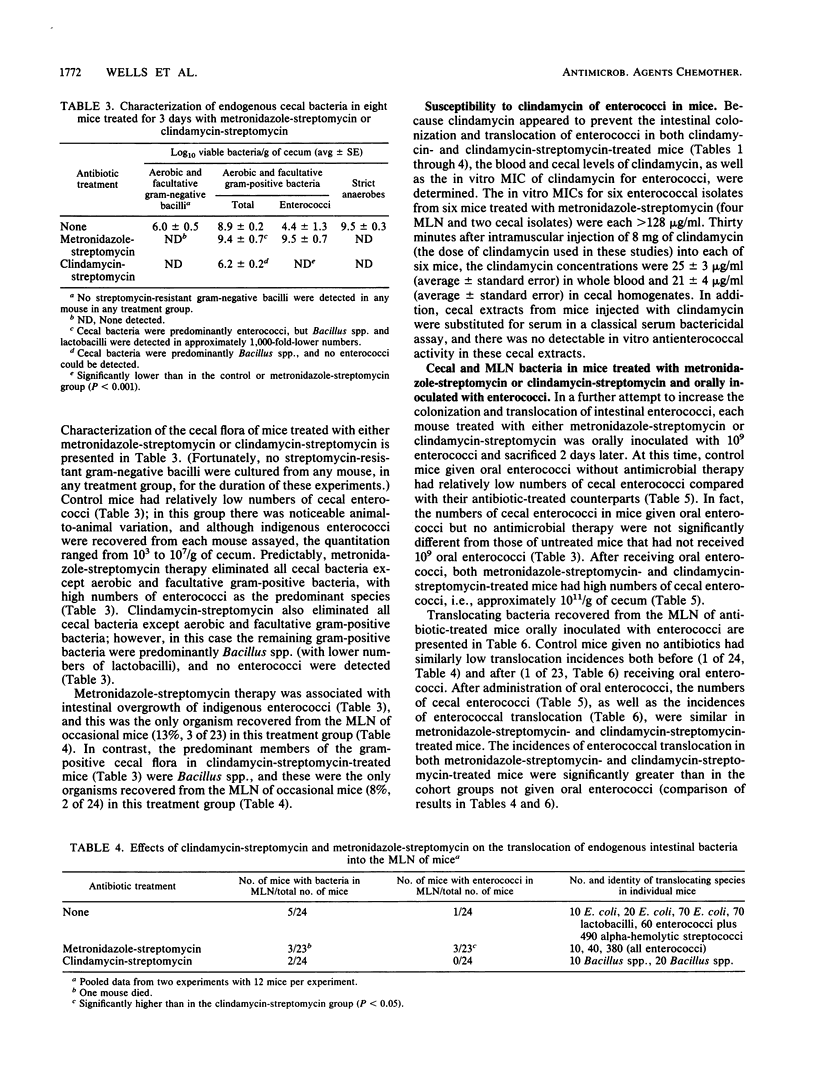
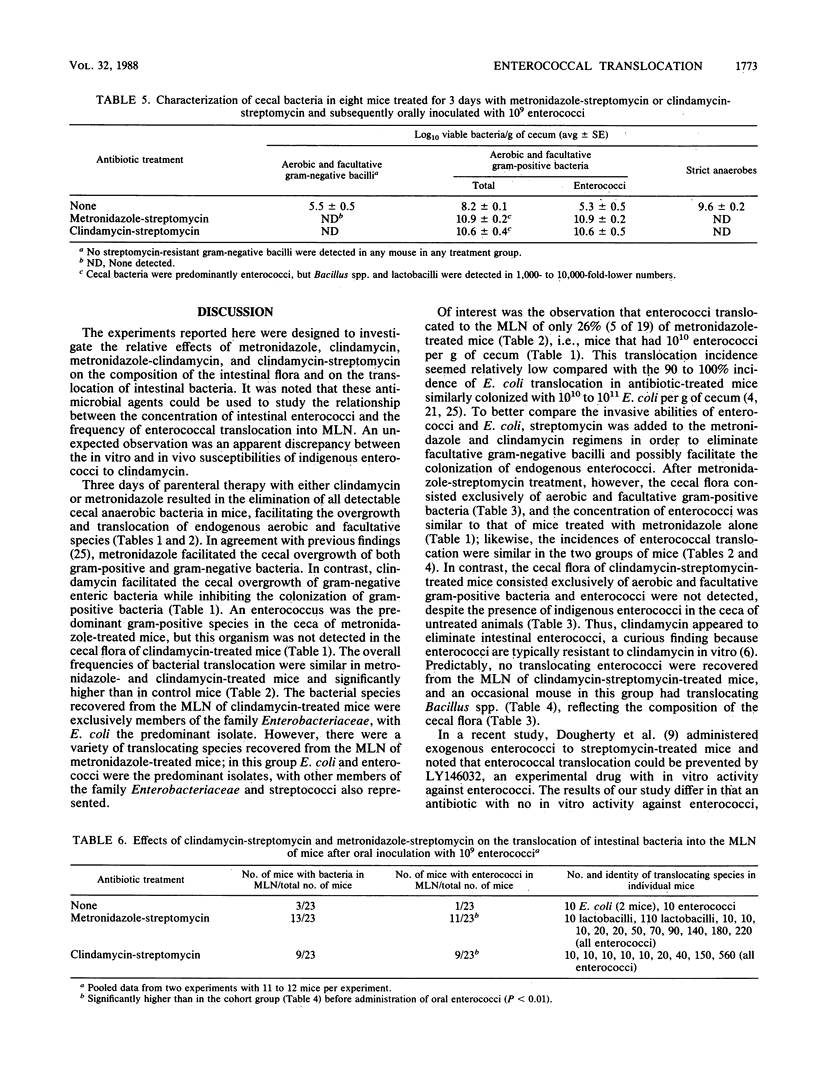
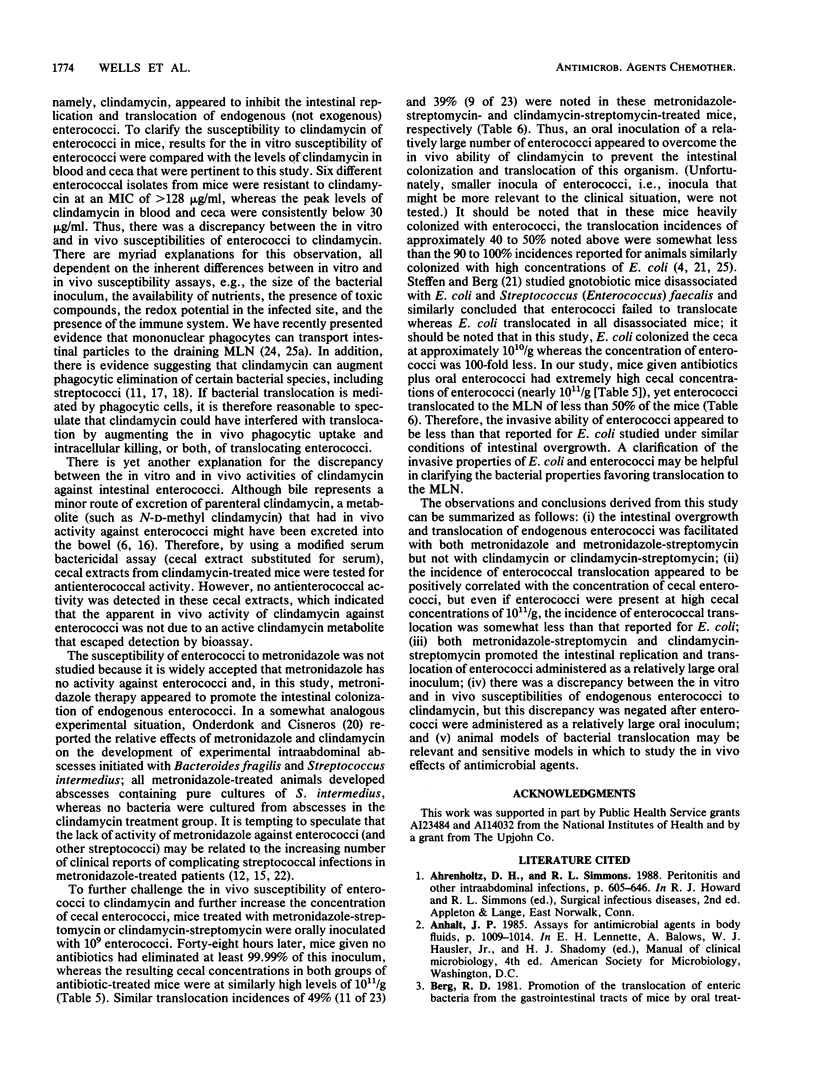
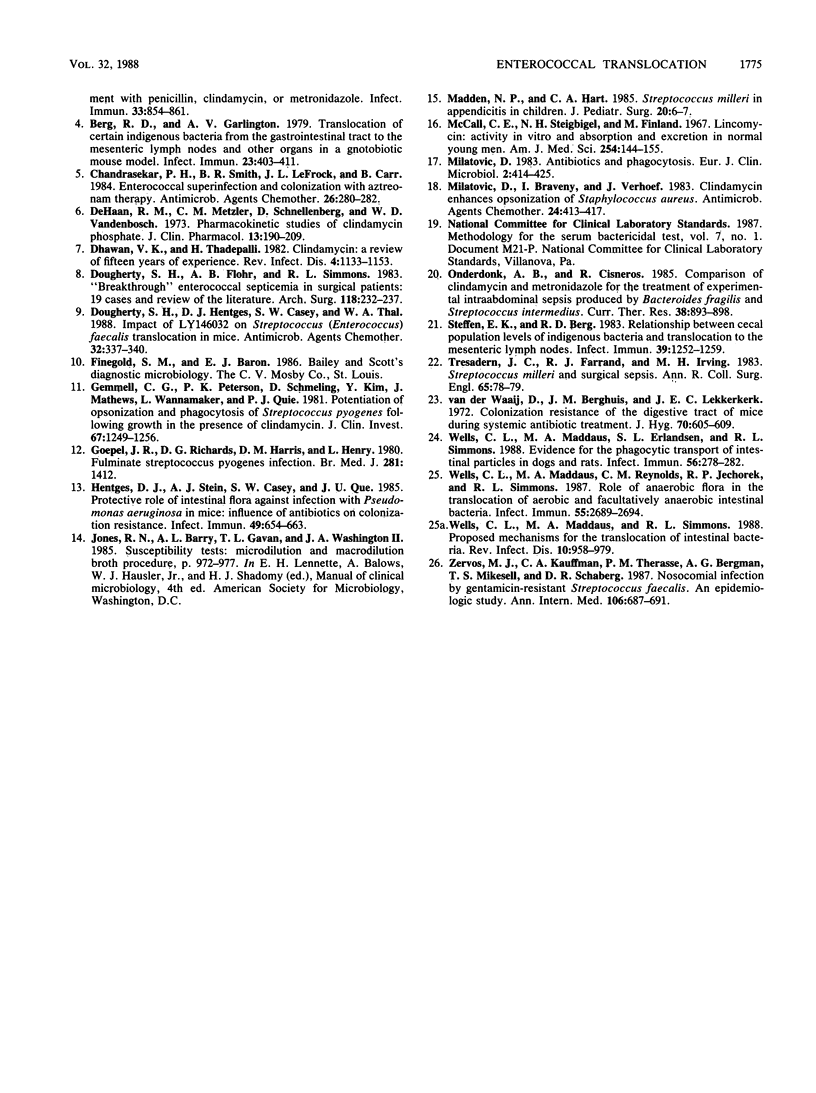
Selected References
These references are in PubMed. This may not be the complete list of references from this article.
- Berg R. D., Garlington A. W. Translocation of certain indigenous bacteria from the gastrointestinal tract to the mesenteric lymph nodes and other organs in a gnotobiotic mouse model. Infect Immun. 1979 Feb;23(2):403–411. doi: 10.1128/iai.23.2.403-411.1979. [DOI] [PMC free article] [PubMed] [Google Scholar]
- Berg R. D. Promotion of the translocation of enteric bacteria from the gastrointestinal tracts of mice by oral treatment with penicillin, clindamycin, or metronidazole. Infect Immun. 1981 Sep;33(3):854–861. doi: 10.1128/iai.33.3.854-861.1981. [DOI] [PMC free article] [PubMed] [Google Scholar]
- Chandrasekar P. H., Smith B. R., LeFrock J. L., Carr B. Enterococcal superinfection and colonization with aztreonam therapy. Antimicrob Agents Chemother. 1984 Aug;26(2):280–282. doi: 10.1128/aac.26.2.280. [DOI] [PMC free article] [PubMed] [Google Scholar]
- DeHaan R. M., Metzler C. M., Schellenberg D., Vandenbosch W. D. Pharmacokinetic studies of clindamycin phosphate. J Clin Pharmacol. 1973 May-Jun;13(5):190–209. doi: 10.1002/j.1552-4604.1973.tb00208.x. [DOI] [PubMed] [Google Scholar]
- Dhawan V. K., Thadepalli H. Clindamycin: a review of fifteen years of experience. Rev Infect Dis. 1982 Nov-Dec;4(6):1133–1153. doi: 10.1093/clinids/4.6.1133. [DOI] [PubMed] [Google Scholar]
- Dougherty S. H., Flohr A. B., Simmons R. L. 'Breakthrough' enterococcal septicemia in surgical patients. 19 cases and a review of the literature. Arch Surg. 1983 Feb;118(2):232–238. doi: 10.1001/archsurg.1983.01390020076013. [DOI] [PubMed] [Google Scholar]
- Dougherty S. H., Hentges D. J., Casey S. W., Thal W. R. Impact of LY146032 on Streptococcus (Enterococcus) faecalis translocation in mice. Antimicrob Agents Chemother. 1988 Mar;32(3):337–340. doi: 10.1128/aac.32.3.337. [DOI] [PMC free article] [PubMed] [Google Scholar]
- Gemmell C. G., Peterson P. K., Schmeling D., Kim Y., Mathews J., Wannamaker L., Quie P. G. Potentiation of opsonization and phagocytosis of Streptococcus pyogenes following growth in the presence of clindamycin. J Clin Invest. 1981 May;67(5):1249–1256. doi: 10.1172/JCI110152. [DOI] [PMC free article] [PubMed] [Google Scholar]
- Goepel J. R., Richards D. G., Harris D. M., Henry L. Fulminant streptococcus pyogenes infection. Br Med J. 1980 Nov 22;281(6252):1412–1412. doi: 10.1136/bmj.281.6252.1412. [DOI] [PMC free article] [PubMed] [Google Scholar]
- Kennedy M. J., Volz P. A. Ecology of Candida albicans gut colonization: inhibition of Candida adhesion, colonization, and dissemination from the gastrointestinal tract by bacterial antagonism. Infect Immun. 1985 Sep;49(3):654–663. doi: 10.1128/iai.49.3.654-663.1985. [DOI] [PMC free article] [PubMed] [Google Scholar]
- Madden N. P., Hart C. A. Streptococcus milleri in appendicitis in children. J Pediatr Surg. 1985 Feb;20(1):6–7. doi: 10.1016/s0022-3468(85)80381-x. [DOI] [PubMed] [Google Scholar]
- McCall C. E., Steigbigel N. H., Finland M. Lincomycin: activity in vitro and absorption and excretion in normal young men. Am J Med Sci. 1967 Aug;254(2):144–155. [PubMed] [Google Scholar]
- Milatovic D. Antibiotics and phagocytosis. Eur J Clin Microbiol. 1983 Oct;2(5):414–425. doi: 10.1007/BF02013898. [DOI] [PubMed] [Google Scholar]
- Milatovic D., Braveny I., Verhoef J. Clindamycin enhances opsonization of Staphylococcus aureus. Antimicrob Agents Chemother. 1983 Sep;24(3):413–417. doi: 10.1128/aac.24.3.413. [DOI] [PMC free article] [PubMed] [Google Scholar]
- Steffen E. K., Berg R. D. Relationship between cecal population levels of indigenous bacteria and translocation to the mesenteric lymph nodes. Infect Immun. 1983 Mar;39(3):1252–1259. doi: 10.1128/iai.39.3.1252-1259.1983. [DOI] [PMC free article] [PubMed] [Google Scholar]
- Tresadern J. C., Farrand R. J., Irving M. H. Streptococcus milleri and surgical sepsis. Ann R Coll Surg Engl. 1983 Mar;65(2):78–79. [PMC free article] [PubMed] [Google Scholar]
- Wells C. L., Maddaus M. A., Erlandsen S. L., Simmons R. L. Evidence for the phagocytic transport of intestinal particles in dogs and rats. Infect Immun. 1988 Jan;56(1):278–282. doi: 10.1128/iai.56.1.278-282.1988. [DOI] [PMC free article] [PubMed] [Google Scholar]
- Wells C. L., Maddaus M. A., Reynolds C. M., Jechorek R. P., Simmons R. L. Role of anaerobic flora in the translocation of aerobic and facultatively anaerobic intestinal bacteria. Infect Immun. 1987 Nov;55(11):2689–2694. doi: 10.1128/iai.55.11.2689-2694.1987. [DOI] [PMC free article] [PubMed] [Google Scholar]
- Wells C. L., Maddaus M. A., Simmons R. L. Proposed mechanisms for the translocation of intestinal bacteria. Rev Infect Dis. 1988 Sep-Oct;10(5):958–979. doi: 10.1093/clinids/10.5.958. [DOI] [PubMed] [Google Scholar]
- Zervos M. J., Kauffman C. A., Therasse P. M., Bergman A. G., Mikesell T. S., Schaberg D. R. Nosocomial infection by gentamicin-resistant Streptococcus faecalis. An epidemiologic study. Ann Intern Med. 1987 May;106(5):687–691. doi: 10.7326/0003-4819-106-5-687. [DOI] [PubMed] [Google Scholar]
- van der Waaij D., Berghuis J. M., Lekkerkerk J. E. Colonization resistance of the digestive tract of mice during systemic antibiotic treatment. J Hyg (Lond) 1972 Dec;70(4):605–610. doi: 10.1017/s0022172400022464. [DOI] [PMC free article] [PubMed] [Google Scholar]


